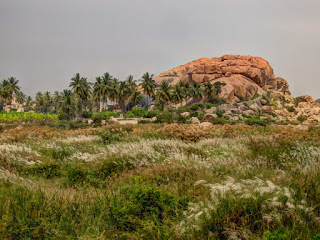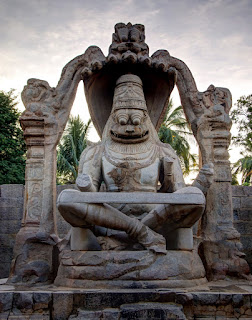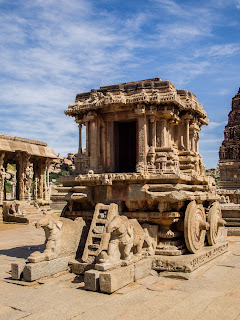As soon as you escape the tethers of electric lines and the
horns of rickshaw drivers and enter the rocky ruins of Hampi, you feel as
though you’ve secretly entered the playground of the gods. Giant round sandstone boulders are littered
everywhere in bizarre stacks and arrangements that seem to defy nature, as if
massive omnipotent hands were bored and rearranged the landscape in idly
whimsical formations. In between these
unlikely cairns, there are temples.
Temples everywhere: wedged under boulders, balancing atop them, and
filling the vaster spaces with handsomely crumbling complexes of a once great
Hindu empire.
And between those –
those temples and palaces still etched with friezes of naughty young handmaidens
and nations of monkeys waging war – there is life, verdant and free. The coconut trees, sugarcane, banana groves, long
feathery grasses, and meadows of delicately colored flowers are home to parrots,
monkeys, tika-painted bovines, and scores of dragonflies and butterflies. Wispy black and white birds tale the flight
trajectory of skipping stones and bounce along invisible planes of water
through pollen misted air. Lost on a trail
and dizzy with happiness, my steps frightened a pair of some kind of water
mammal which dove into the river one after the other.
Too much splendor to take in by foot, I had been renting
bicycles and traversing the landscape in search of beauty until the point of
exhaustion, stopping whenever I might capture a living painting with my lens or
the distant sound of festive music draws me back to humanity – like the
chanting tumbling down from a hill top Krishna temple or the frenzied melodies
of a wedding band near the Jain ruins.
Upon my inspection of the wedding band, I was nearly devoured alive by
bands of little Indian boys and girls, all wanting to shake my hand a healthy
four or five times each. Wanting to
enjoy the music, I let my whole right arm go limp and let them do whatever they
wanted with it.
The allure of the Vijayanagar kingdom’s ruins captures also
the interest of Russian tour bus groups and whole ashrams of white dreadlocked
yoga-mat hippies alike, but the ruins are expansive enough to accommodate all,
and I found it didn’t take much effort to have a slice of paradise to enjoy
with solitude.
The villagers surrounding Hampi know neither English nor
Hindi, nor do they really need to. As I
biked around cursing goatherds, sari donned women balancing huge jugs of water
on their heads, and falling coconuts let loose from machete wielding collectors,
I got the sense very little has changed for these people since the first temple
stones were being laid and monkey and lion headed gods sipped nectar in their
palace gardens.
Laxshmi, the village elephant, lives in Rupaksha Temple in
the heart of the modern part of the village and takes her bath at 8:30 every
morning. Before heading down, she pauses
to bless adoring tourists who have rupees or snacks for her: bananas eaten
whole or coconuts crushed to pieces with a single effortless stomp. She then walks down the ghat steps to the river
with surprising nimbleness and then lays down on her side so her mahouts can
scrub her clean with large coarse brushes.
The ghats are also where people wait to cross the river,
either en masse in motorboats or more intimately by paddlers in tiny discuss shaped
craft made from some kind of plant weaving and layers of waterproof tar. It was here, waiting for the boat, a small
brown man sat next to me with a pair of flat wicker baskets and said, “Here. Snake.
Take photo,” and then he pulled out a gourd-turned-flute and out of the
baskets came three very charmed cobra snakes with their hoods flared
mightily. A big part of me didn’t want
to let myself be entertained by a poacher, but another part was going, holy shit – cobras, and this part spoke at
least a little bit louder. Two of the
cobras seemed helplessly entranced by the player’s swaying and the nasally
drone of his flute, but the largest of the three wasn’t having any of it and
alternated between trying to escape and taking dart like swipes at its very
unfazed master. After the performance
the charmer tried handing me a cobra, which predictably caused me to shrink
away with alarm, but after some very persistent cajoling by a few other
villagers (I was the only white guy present at the time), I let myself think:
okay, well obviously the poison glands have been removed somehow, so worst case
scenario, I have a pair of puncture marks to take home as a souvenir. Despite all my rationalizing, when I had a
live cobra working very calmly up my arm and around my neck, more out of an
attempt to placate the villagers than my own curiosity, I very much wanted it
off.
I stayed in a tiny room at the Hampi Children’s Trust, a
volunteer run school for maybe two to three dozen impoverished children, in
exchange for some of my time and a modest donation. I did a bit of tutoring, and I cleaned a
great deal of dishes, but I think I was the most uniquely useful as a human
jungle gym, and during play hours the kids slithered up my legs onto my shoulders,
and if they were lucky and I had the energy I would throw them in the air or
spin them in circles by their wrists and ankles. But give an inch and they take a mile. If I was too exhausted to spin the next in
kid in the growing queue, tears would start to well up, and what started out as
lighthearted fun demanded my most careful judiciousness on how to keep them
happy without killing myself. On
Saturday, the kids had a half-day of studies and then they gathered up soccer
balls, tiny tennis rackets, hula-hoops, and Frisbees, and we all migrated to the
same temple complex where enjoyed perhaps the best sunrise of my life after stumbling
off of my overnight bus on my first day in Hampi.
One morning, I followed a yoga course in a shady temple
courtyard between a mossy step well and an enshrined jungle tree. Another afternoon, I got lost in a valley
beyond the river, and laid eyes upon my first kingfisher; its wings were such
an ethereal blue I then understood why people spoke of them with such reverence. I climbed a deliriously endless flight of
stairs to the mountain top where Hanuman, the monkey god was born. In a partially underground Shiva temple, rain
water had flooded the lowest level, and proceeding without getting wet meant
shimmying along wall surfaces, tiptoeing on fallen columns, hopping past plates
jutting up from the water surface that only afforded the walker a moment of
stability before becoming overcome by fluid, and toward the blackness that
enclosed the Shiva linga at the back of the temple, dodging bats. It felt very much like navigating the exact
kind of obstacles and atmosphere presented in adventure videogames, except
instead of trying to recover the ancient artifact, I was trying to find the
best angle to take an image without getting my pants wet.
Amid all the unbelievable beauty, however, I also saw one of
the worst things I’ve ever seen. I won’t
even include it here, but if you’re not terribly squeamish, you can email me
and I’ll tell you.
I drank from around five coconuts a day trying to reclaim
the sweat expended while biking around in the thick Indian heat, and I guzzled
the lovely juice with disbelief that I was there during the cool season. The best coconut vendors could hack their
wares violently, but precisely, and can have a coconut open with an inviting
straw with three slices from a dull machete in just two seconds. Three quick hacks more, and the coconut is
split in half, and a tiny scoop shaped sliver is cut from the side to help pull
the coconut’s meat from the husk. By the
river, next to a sign warning of crocodiles, I drank an amazing fresh cane juice
pressed from over two meters of sugar cane, half a lemon, and a hunk of
ginger. In the tourist village, I was
addicted to the partially real imitations of mango juice sold in tiny cartons,
and in restaurants – if I wasn’t guzzling chai – I drank soda water and lime
juice, served with sugar and salt on the side to add to taste. On my final free day in India, I drank a
special lassi and climbed Matanga Hill, making belief I was a sadhu meditating
high above a quilt work of temples, rivers, and banana groves. Distant drums and the chirping of parrots
were my soundtrack before I put Abbey Road in my ears and succumbed to a deep
midafternoon nap, and waking just before a barrel or two of monkeys were making
their daily migrations in my direction.
I didn’t realize it at first, but I had laid down in something of a
thorn bush, and I as I rose from my nap, a thorn tugged at the blood and
saffron colored bracelet that had been wrapped around wrist since Diwali, which
became a saddening yet appropriate symbol for the finality of my time in India.
Hampi was everything
I wanted to squeeze out of my last moments in India (except, I should mention, for
the food which was uncommonly mediocre).
I had originally planned on splitting my final week between Hampi,
Mysore, and Bengaluru, but opted to linger in Hampi until my departure was demanded
by my booked flight to Nepal. In my
final hours there, I became listless, awed by all I’ve done, but bereft of all I
still wanted to see and do. For
everyplace I went, I learned of ten more I wanted to explore, and I was hardly
ready to go. What had been five of the
most bewildering and frustrating weeks of my life have also been among the most
vivid and exciting. I feel like I’ve
just begun my relationship with India. I
was sad to go, but happy about where I was: in love with where I’ve been,
stimulated by where I was, and excited about what’s to come. I









1 comment:
Hello,
I was in Hampi last year, and am looking at going back in February, mainly to do some work with the Children's Trust. I was wondering if I might ask you some questions about your time volunteering there?
Noah
Post a Comment